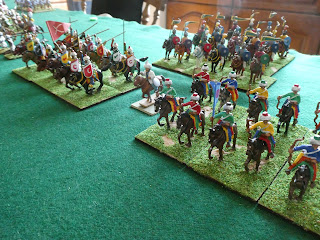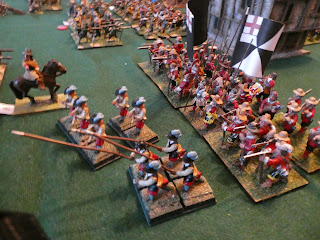Anxious to carry out his orders to cover the deployment of the Royalist infantry, Sir Royston a Dames led his brigade of horse to the right towards the Parliamentary cavalry. One regiment, Catlow's, followed orders a little too enthusiastically and strayed into range of the enemy infantry and artillery who inflicted heavy casualties on the unsupported Cavaliers. It was only the refusal of the Parliamentary regiments on the ridge to charge their shaken opponents that saved this element of Sir Royston's command.
 |
| The waiting Parliamentary cavalry |
 |
| The impetuous Royalist cavalry, with Sir Royston striving to bring forward supports |
Back on the road, Lord Melchett was directing the dragoon regiment to the left to be followed by the infantry from Saville's brigade; the regiments of Strickland, Bradshaw and Harrington. Behind the infantry was a light gun which was to move forward to support the right flank of the infantry.
 |
| The Royalist infantry move forward to deploy |
Whilst the infantry deployed prior to advancing on the enclosure, which was occupied by Parliamentary dragoons, disaster had befallen Sir Royston's cavalry. The Catlow's, already shaken by losses from musketry and artillery, received further punishment from the Parliamentary forces. This proved too much and the survivors routed. The Parliamentary cavalry moved forward as Sir Royston struggled to rally his troopers. Turning to his remaining regiment, Ashton's, he ordered them to hold off the enemy long enough for their colleagues to reform and the remaining regiments of he brigade make their way forward from the rear of the column. A tough task, given that the Royalists would be outnumbered 3 to 1, but Ashton's did their best. They were charged by Thursby's regiment, supported on their right by Bannister's. Although outnumbered the Royalists held their ground, gaining time for Sir Royston and also a small unit of commanded shot, which Lord Melchett had sent to the right flank to provide flanking fire from the safety of a small wood. Determined to make rapid progress, Robinson committed his remaining regiment, Clayton's, to the melee. Ashton's fought on but began to give ground and then suddenly routed. Although they had suffered heavy casualties, they had bought enough time for Sir Royston to rally Catlow's regiment. Also, Thursby's and Clayton's regiments needed time to recover from the melee, so the commanded shot managed to reach the safety of the trees.
 |
| Ashton's regiment routs |
In the centre the infantry battle was beginning. Once the Royalist intentions became clear, Sir Charles ordered his infantry forward. Mytton and Leck headed towards the Royalist left; Ireby's moved to take over from the dragoons in the enclosure and Clarke's regiment advanced down the road. The Parliamentary dragoons certainly needed help. They were being destroyed by the fire from Strickland's and had begun to waver. Sensing an opportunity, Melchett ordered a charge, but the message never reached Strickland's and the chance was lost. By the time a second message was sent, Ireby's had replaced the dragoons and they provided a stronger defence. Harrington's, a newly raised regiment, faced two enemy units, but did have the support of the dragoons. Both Harrington's and Strickland's were suffering increasing casualties, the light artillery had still not arrived and Bradshaw's were facing Clarke's larger unit.
 |
| The infantry battle in the centre, with Catlow's attacked by Bannister's in the foreground |
Having rallied Catlow's regiment, Sir Royston galloped off to try and do the same for Ashton's. Robinson had sent forward Bannister's to try and finish off Catlow's. Now under-strength, the Royalist cavalry stood little chance against their new opponents. In no time at all they broke and scattered, fleeing the field. Fortunately for the Royalist cause, the remaining cavalry regiments, those of Bracewell and De Lisle had now deployed.
 |
| Catlow's flee the field |
Although the Royalists now had cavalry to oppose Robinson's troops, they had lost Sir Royston. He had been swept from the field with the routing Ashton's so Lord Melchett found himself in sole control of all the troops. The Royalist position was not too favourable, but Lord Melchett ordered the regiments of Bracewell and De Lisle to counter attack. This they did, but not before the luckless artillery had been overrun by Bannister's regiment. Slow to advance, the artillery had not even deployed before being inundated by the Parliamentary cavalry. Lord Melchett's counter attack was a failure. Both Royalist regiments were routed by their opponents and Sir Royston arrived back on the field to see the remnants of his brigade fleeing in the opposite direction.
With the success of Robinson's cavalry, Sir Charles had decided to increase the pressure on the Royalist infantry by ordering Clarke's regiment to charge Bradshaw's. The charge had been a failure, a short range volley had stopped it in it's tracks. However, a charge by Bradshaw's proved even less successful. Although the Royalist infantry closed to contact, they were thoroughly bested in the melee and routed.
The day was undoubtedly lost for the Royalists; with no cavalry to speak of, outnumbered in infantry and no artillery, any idea of continuing the advance was out of the question. Sir Charles ordered Robinson to harry the Royalists and round up prisoners while he visited his weary infantry regiments.
An enjoyable game though a rather one-sided affair. The dice did not favour the Royalists. They failed too many command tests in the beginning which made their deployment too slow and far too disjointed. Then when battle commenced they failed to win a single melee. It could have been worse had the Parliamentary force also not failed some crucial attempts at charging.






























